Скрипят опоры
Ходовая часть Audi Q3 просит первого ремонта достаточно рано. Например, опорные подшипники переднего McPherson из-за беспрепятственного выхода смазки часто начинают поскрипывать и похрустывать ещё до 50 ткм.
Подшипник, потерявший смазку
К 100 000 км можно готовиться к более серьезному ремонту подвески. К этому моменту обычно приходят в негодность сайлентблоки передних рычагов, причем владельцы Q3 приспособились ставить резинки от заряженной версии RS – они жестче и выносливее. Другое дело, что комфорт тоже страдает.
Сайлентблоки передних рычагов иногда примеряют от заряженных версий Audi Q3
Амортизаторы, как и ступичные подшипники тут живут примерно
по 150 ткм, в зависимости от манеры езды и качества дорожного полотна в вашем
городе.
Лопнувший нижний виток пружины
Задняя подвеска Audi Q3, а точнее сайлентблоки многочисленных рычагов, неплохо сохраняют свои заводские детали на протяжении первых 200 000 км, а дальше нужно быть готовым срезать развальные болты, так как к этому моменту они намертво прикипают:
С рулевым управлением проблемы встретишь не часто. Стоит
периодически следить за пыльниками рулевой рейки, иначе дорогостоящий узел ждет
выход смазки, коррозия и уход на покой вместе с электроусилителем под стуки
увеличившихся люфтов. Такие случаи бывают.
Заржавевшие механизмы ЭУР из-за потерянной смазки
Small overlap front: driver-side
Rating applies to 2019-23 models
Tested vehicle: 2019 Audi Q3 2.0T Premium Plus quattro 4-door 4wd
The Audi Q3 was redesigned for the 2019 model year. Driver-side small overlap frontal ratings are assigned by the Institute based on a test conducted by Volkswagen/Audi as part of .
| Overall evaluation | G |
|---|---|
| Structure and safety cage | G |
| Driver injury measures | |
| Head/neck | G |
| Chest | G |
| Hip/thigh | G |
| Lower leg/foot | G |
| Driver restraints and dummy kinematics | G |
Technical measurements for this test
Measures of occupant compartment intrusion on driver side
| Test ID | VTN1912 |
|---|---|
| Lower occupant compartment | |
| Lower hinge pillar max (cm) | 10 |
| Footrest (cm) | 7 |
| Left toepan (cm) | 4 |
| Brake pedal (cm) | 4 |
| Parking brake (cm) | |
| Rocker panel lateral average (cm) | 1 |
| Upper occupant compartment | |
| Steering column | 3 |
| Upper hinge pillar max (cm) | 6 |
| Upper dash (cm) | 6 |
| Lower instrument panel (cm) | 7 |
Driver injury measures
| Test ID | VTN1912 |
|---|---|
| Head | |
| HIC-15 | 173 |
| Peak gs at hard contact | no contact |
| Neck | |
| Tension (kN) | 1.1 |
| Extension bending moment (Nm) | 17 |
| Maximum Nij | 0.21 |
| Chest maximum compression (mm) | 28 |
| Femur (kN) | |
| Left | 1.5 |
| Right | 0.9 |
| Knee displacement (mm) | |
| Left | 1 |
| Right | 1 |
| Knee-thigh-hip injury risk (%) | |
| Left | |
| Right | |
| Maximum tibia index | |
| Left | 0.37 |
| Right | 0.67 |
| Tibia axial force (kN) | |
| Left | 2.1 |
| Right | 2.3 |
| Foot acceleration (g) | |
| Left | 69 |
| Right | 52 |
Side: updated test
Rating applies to 2019-23 models
Tested vehicle: 2021 Audi Q3 S 2.0T Premium Plus quattro 4-door 4wd
The Audi Q3 was redesigned for the 2019 model year.
| Overall evaluation | A |
|---|---|
| Structure and safety cage | A |
| Driver injury measures | |
| Head/neck | G |
| Torso | A |
| Pelvis | P |
| Driver head protection | G |
| Rear passenger injury measures | |
| Head/neck | G |
| Torso | A |
| Pelvis | A |
| Rear passenger head protection | G |
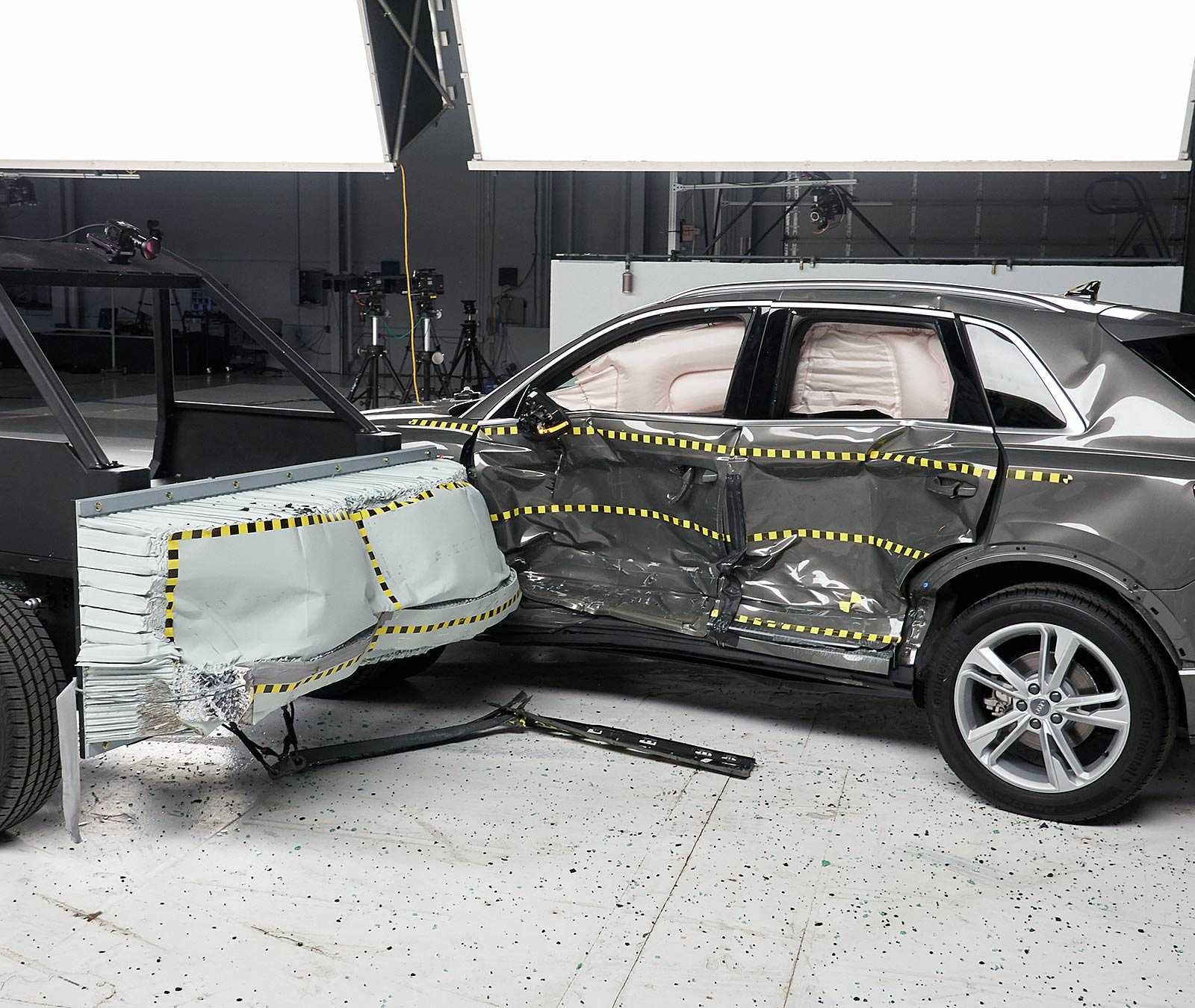
View of the vehicle just after the crash test.
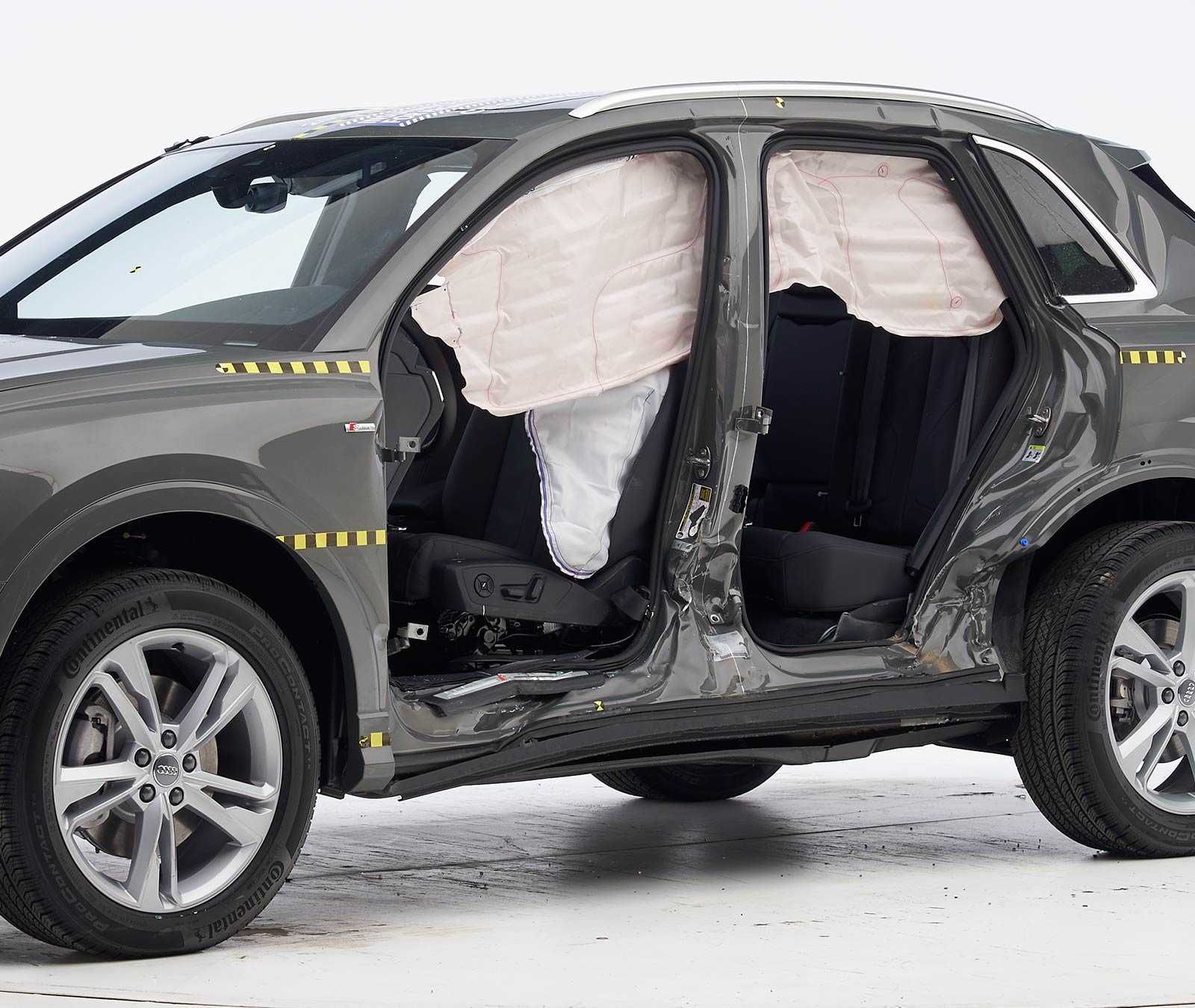
View of the vehicle after the crash with doors removed, showing the side airbags and damage to the occupant compartment.
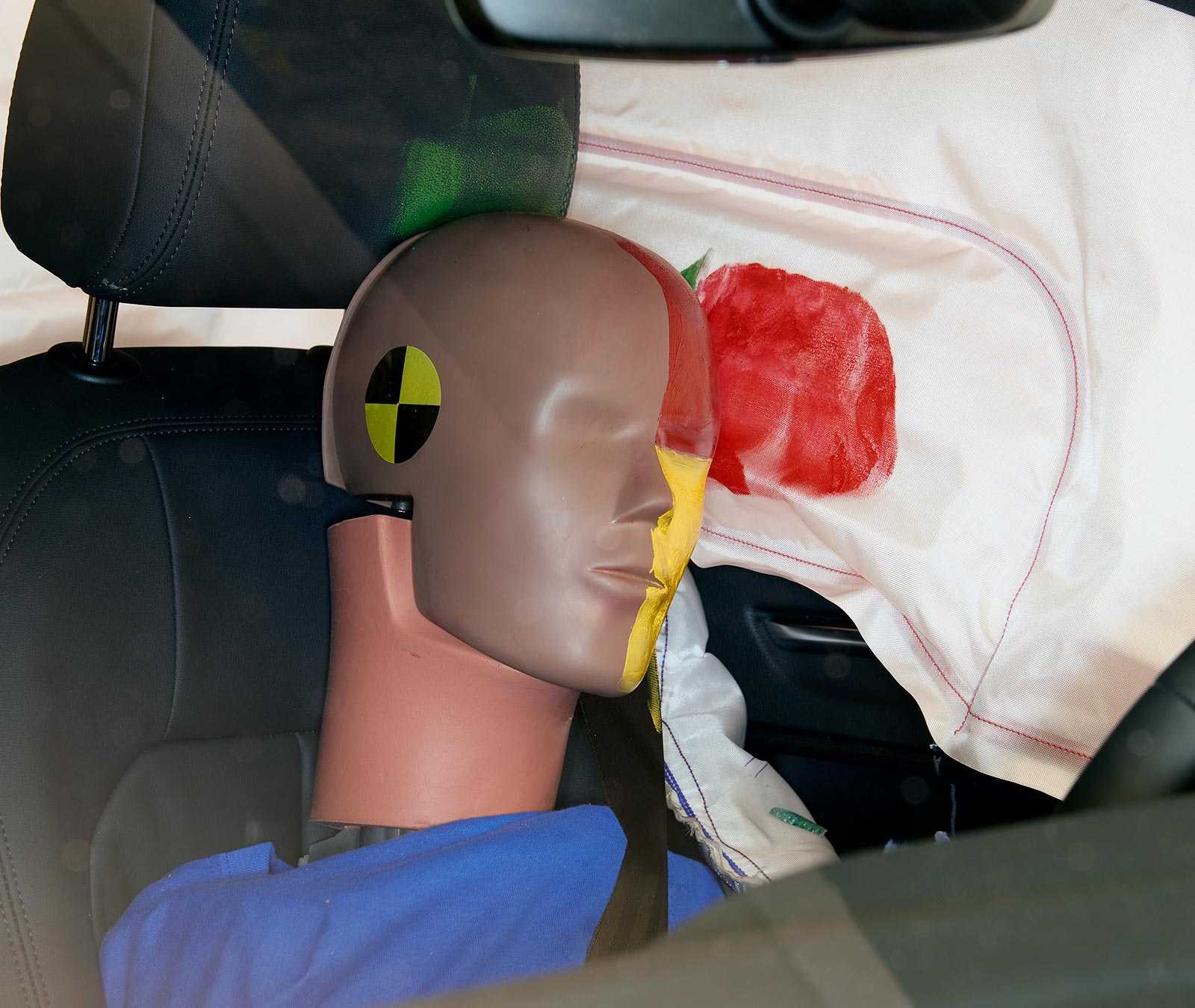
Smeared greasepaint shows where the driver dummy’s head was protected from being hit by hard structures by the side airbags.
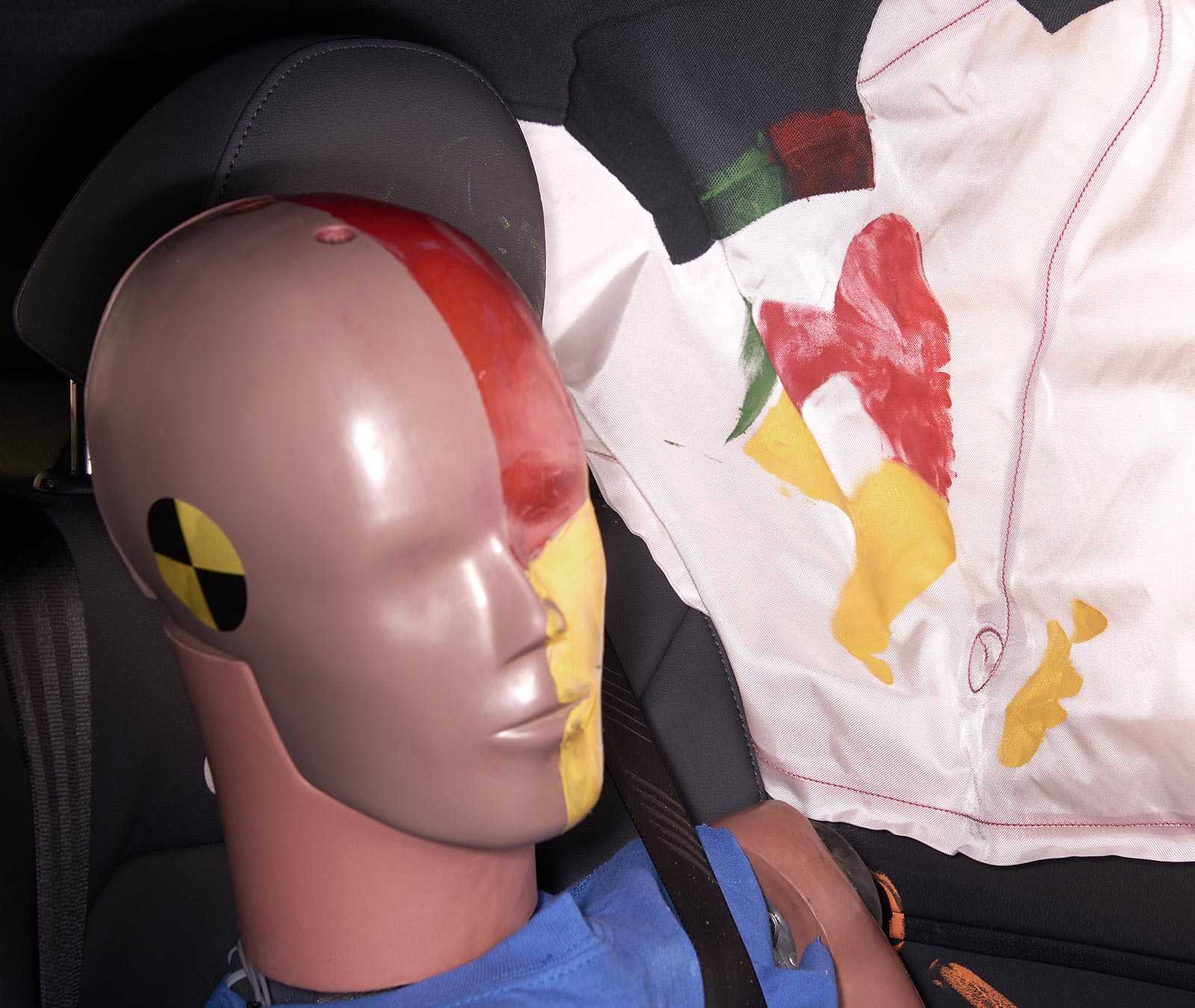
Smeared greasepaint shows where the rear passenger dummy’s head was protected by the side airbag.
Technical measurements for this test
Measures of occupant compartment intrusion on driver side
| Test ID | CES2003 |
|---|---|
| B-pillar to longitudinal centerline of driver’s seat (cm) | -17.5 |
| Negative numbers indicate the amount by which the crush stopped short of the seat centerline. |
Driver injury measures
| Test ID | CES2003 |
|---|---|
| Head | |
| HIC-15 | 190 |
| Peak gs at hard contact | no contact |
| Neck | |
| Tension (kN) | 1.5 |
| Compression (kN) | 0.3 |
| Shoulder | |
| Lateral deflection (mm) | 27 |
| Lateral force (kN) | 1.3 |
| Torso | |
| Maximum deflection (mm) | 31 |
| Average deflection (mm) | 29 |
| Maximum deflection rate (m/s) | 2.66 |
| Maximum viscous criterion (m/s) | 0.46 |
| Pelvis | |
| Combined force (kN) | 6.3 |
Passenger injury measures
| Test ID | CES2003 |
|---|---|
| Head | |
| HIC-15 | 329 |
| Peak gs at hard contact | no contact |
| Neck | |
| Tension (kN) | 0.5 |
| Compression (kN) | 0.3 |
| Shoulder | |
| Lateral deflection (mm) | 51 |
| Lateral force (kN) | 1.7 |
| Torso | |
| Maximum deflection (mm) | 44 |
| Average deflection (mm) | 35 |
| Maximum deflection rate (m/s) | 4.90 |
| Maximum viscous criterion (m/s) | 0.93 |
| Pelvis | |
| Combined force (kN) | 4.7 |
Moderate overlap front: updated test
Rating applies to 2021-23 models
Tested vehicle: 2021 Audi Q3 S 2.0T Premium Plus quattro 4-door 4wd
The Audi Q3 was redesigned for the 2019 model year.
| Overall evaluation | M |
|---|---|
| Structure and safety cage | G |
| Driver injury measures | |
| Head/neck | G |
| Chest | G |
| Thigh/hip | G |
| Leg/foot | G |
| Driver restraints and dummy kinematics | G |
| Rear passenger injury measures | |
| Head/neck | A |
| Chest | G |
| Thigh | G |
| Rear passenger restraints and dummy kinematics | P |
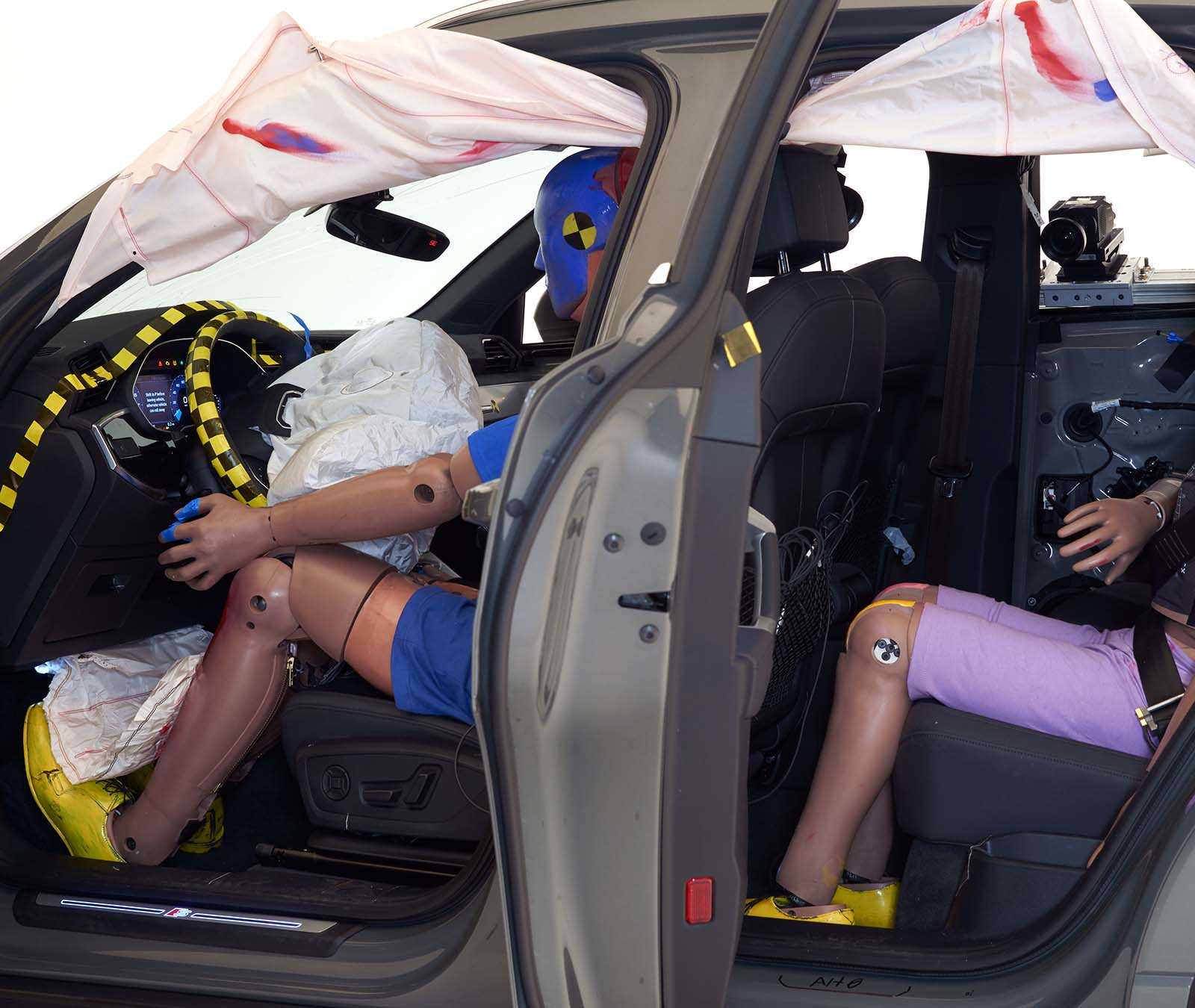
View of the vehicle after the crash showing the airbags and damage to the occupant compartment.
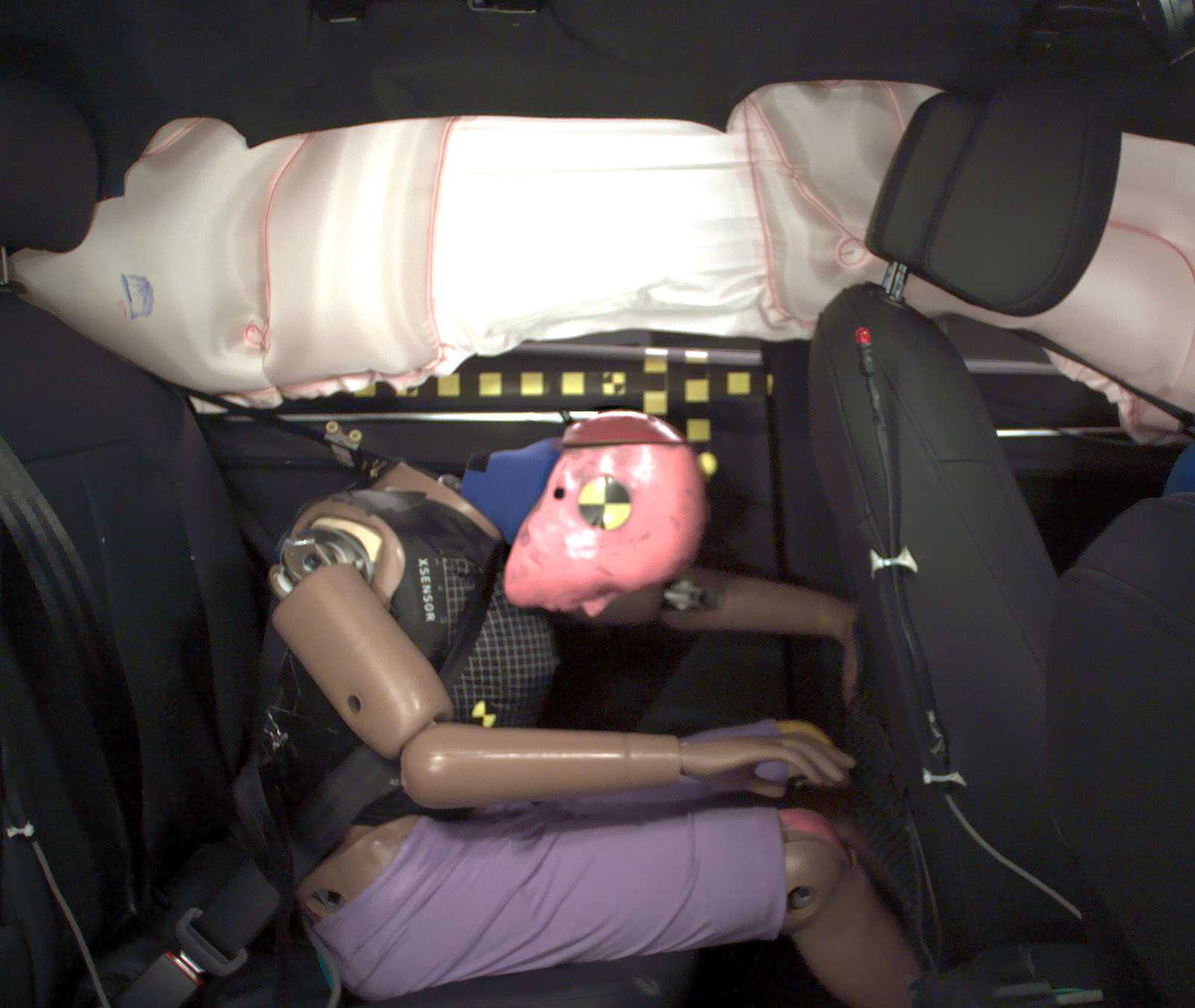
The rear passenger dummy’s head approached the front seatback, which increases the risk of head injuries.

Rear passenger dummy injury values indicate a low risk of injury to the chest and a moderate risk of injury to the head or neck.
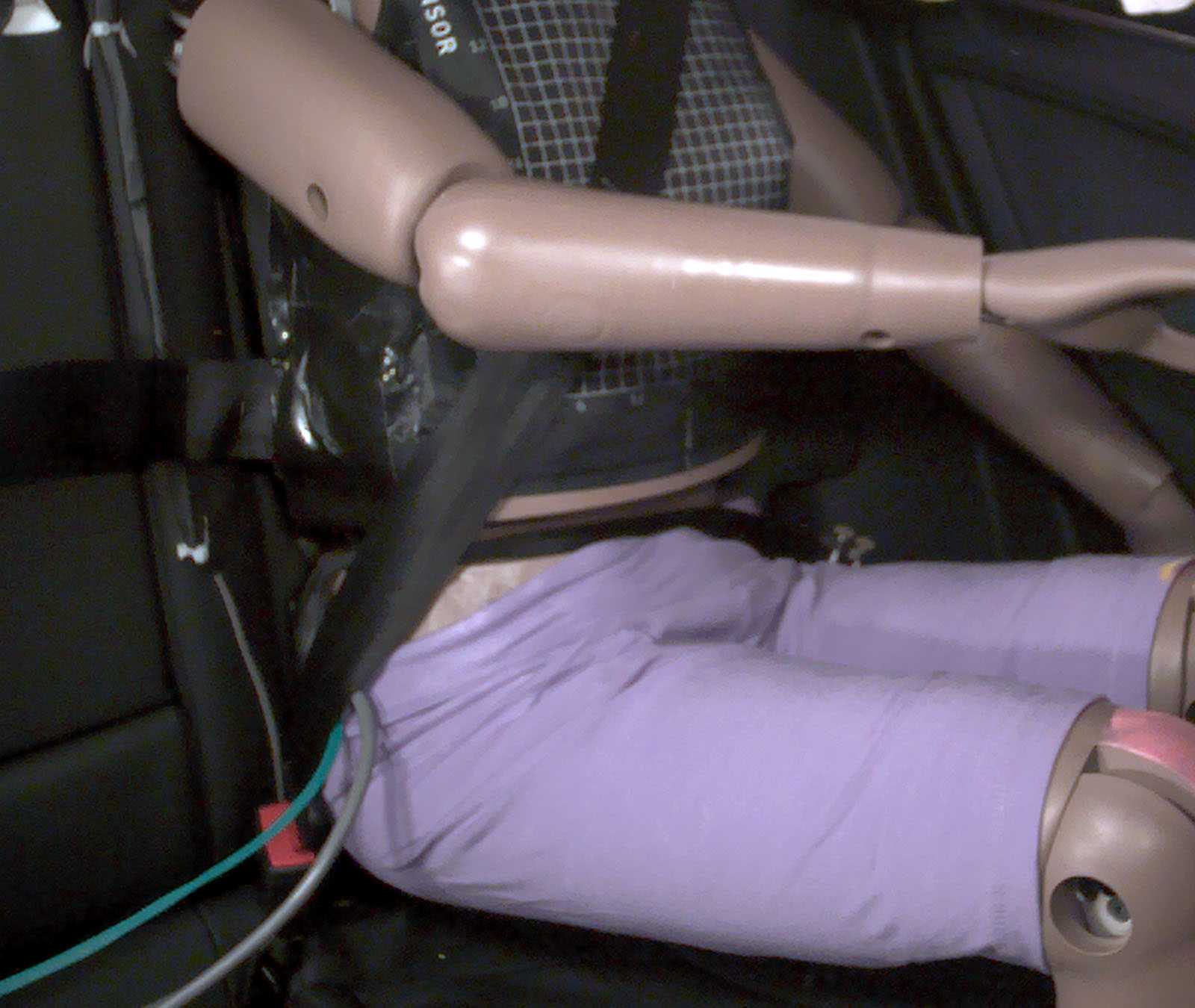
The rear passenger dummy’s lap belt moved from the ideal position on the pelvis into the abdomen, increasing the risk of abdominal injuries.
Technical measurements for this test
Measures of occupant compartment intrusion on driver side
| Test ID | CEF2105 |
|---|---|
| Footwell intrusion | |
| Footrest (cm) | 3 |
| Left (cm) | 10 |
| Center (cm) | 5 |
| Right (cm) | 1 |
| Brake pedal (cm) | 3 |
| Instrument panel rearward movement | |
| Left (cm) | |
| Right (cm) | |
| Steering column movement | |
| Upward (cm) | -2 |
| Rearward (cm) | -6 |
| A-pillar rearward movement (cm) |
Driver injury measures
| Test ID | CEF2105 |
|---|---|
| Head | |
| HIC-15 | 288 |
| Peak gs at hard contact | no contact |
| Neck | |
| Tension (kN) | 1.2 |
| Extension bending moment (Nm) | 19 |
| Maximum Nij | 0.26 |
| Chest maximum compression (mm) | 36 |
| Femur (kN) | |
| Left | 0.6 |
| Right | 0.6 |
| Knee displacement (mm) | |
| Left | 1 |
| Right | 1 |
| Knee-thigh-hip injury risk (%) | |
| Left | |
| Right | |
| Maximum tibia index | |
| Left | 0.25 |
| Right | 0.42 |
| Tibia axial force (kN) | |
| Left | 2.1 |
| Right | 2.8 |
| Foot acceleration (g) | |
| Left | 73 |
| Right | 75 |
Rear passenger injury measures
| Test ID | CEF2105 |
|---|---|
| Head | |
| HIC-15 for head contact during forward excursion | no contact |
| Peak gs at hard contact | no contact |
| Neck | |
| Tension (kN) | 2.4 |
| Compression (kN) | 0.2 |
| Maximum Nij for head contact during forward excursion | no contact |
| Chest | |
| Chest maximum compression (mm) | 20 |
| Shoulder belt tension (kN) | 4.2 |
| Maximum shoulder belt position (mm) | 101 |
| Thigh (kN) | |
| Left femur compression | 0.1 |
| Right femur compression | 0.2 |
Moderate overlap front: original test
Rating applies to 2019-23 models
Tested vehicle: 2019 Audi Q3 2.0T Premium Plus quattro 4-door 4wd
The Audi Q3 was redesigned for the 2019 model year. Moderate overlap frontal ratings are assigned by the Institute based on a test conducted by Volkswagen/Audi as part of .
| Overall evaluation | G |
|---|---|
| Structure and safety cage | G |
| Driver injury measures | |
| Head/neck | G |
| Chest | G |
| Leg/foot, left | G |
| Leg/foot, right | G |
| Driver restraints and dummy kinematics | G |
Technical measurements for this test
Measures of occupant compartment intrusion on driver side
| Test ID | VTF1917 |
|---|---|
| Footwell intrusion | |
| Footrest (cm) | 3 |
| Left (cm) | 3 |
| Center (cm) | 5 |
| Right (cm) | 2 |
| Brake pedal (cm) | 2 |
| Instrument panel rearward movement | |
| Left (cm) | |
| Right (cm) | |
| Steering column movement | |
| Upward (cm) | -2 |
| Rearward (cm) | -6 |
| A-pillar rearward movement (cm) | 2 |
Driver injury measures
| Test ID | VTF1917 |
|---|---|
| Head | |
| HIC-15 | 245 |
| Peak gs at hard contact | no contact |
| Neck | |
| Tension (kN) | 1.6 |
| Extension bending moment (Nm) | 13 |
| Maximum Nij | 0.30 |
| Chest maximum compression (mm) | 34 |
| Legs | |
| Femur force — left (kN) | 0.5 |
| Femur force — right (kN) | 0.8 |
| Knee displacement — left (mm) | |
| Knee displacement — right (mm) | 1 |
| Maximum tibia index — left | 0.36 |
| Maximum tibia index — right | 0.44 |
| Tibia axial force — left (kN) | 1.9 |
| Tibia axial force — right (kN) | 3.9 |
| Foot acceleration (g) | |
| Left | 71 |
| Right | 138 |
Child seat anchors
Applies to 2019-23 models
| Overall evaluation |
G extra LATCH positions |
| Vehicle trim | 2.0T Premium Plus |
| Seat type | leather |
This vehicle has 2 rear seating positions with complete child seat attachment (LATCH) hardware.
It has 1 additional seating position with a tether anchor and the ability to borrow lower anchors from the other seating positions.
Note: When anchors are borrowed, they aren’t available to use in their designated positions.
| Overall evaluation |
G extra LATCH positions |
| Vehicle trim | 2.0T Premium Plus |
| Seat type | leather |
123
| G | Good |
| A | Acceptable |
| M | Marginal |
| P | Poor |
| Seating positions that rely on borrowed lower anchors or have only a tether anchor available are not rated. | |
| thether anchor symbol | Tether anchor |
| lower anchor symbol | Lower anchors |
| Lower anchor(s) can be borrowed from adjacent positions(s) | |
| No hardware available |
Details by seating position
| 1 | |
|---|---|
| Tether anchor | |
| easy-to-find location | |
| no other hardware could be confused for anchor | |
| Lower anchors | |
| not too deep in seat | |
| not too much force needed to attach | |
| easy to maneuver around anchors | |
| 2 | |
| Tether anchor | |
| easy-to-find location | |
| no other hardware could be confused for anchor | |
| Lower anchors | |
| Can be borrowed from 1 and 3 | |
| 3 | |
| Tether anchor | |
| easy-to-find location | |
| no other hardware could be confused for anchor | |
| Lower anchors | |
| not too deep in seat | |
| not too much force needed to attach | |
| easy to maneuver around anchors |
Technical measurements for this test
Seat position 21
3
| Lower anchor A | |
|---|---|
| Open access rated | No |
| Depth (cm) | -2-0 |
| Force (lbs) | 2 |
| Clearance angle (degrees) | 79 |
| Lower anchor B | |
| Open access rated | Yes |
| Depth | Visible |
| Force (lbs) | 1 |
| Clearance angle (degrees) | 81 |
| Tether anchor | |
| Location | Middle seatback |
| Confusing hardware present | Yes |
| Has contrasting label within 3 inches of tether anchor | Yes |
Seat position 22
2
| Lower anchor A | |
|---|---|
| Lower latch is shared for this seat position | |
| Lower anchor B | |
| Lower latch is shared for this seat position | |
| Tether anchor | |
| Location | Middle seatback |
| Confusing hardware present | Yes |
| Has contrasting label within 3 inches of tether anchor | Yes |
Seat position 23
1
| Lower anchor A | |
|---|---|
| Open access rated | Yes |
| Depth | Visible |
| Force (lbs) | 1 |
| Clearance angle (degrees) | 83 |
| Lower anchor B | |
| Open access rated | No |
| Depth (cm) | 0-2 |
| Force (lbs) | 4 |
| Clearance angle (degrees) | 83 |
| Tether anchor | |
| Location | Middle seatback |
| Confusing hardware present | Yes |
| Has contrasting label within 3 inches of tether anchor | Yes |
Child seat anchors
Applies to 2016-18 models
| Overall evaluation |
A |
| Vehicle trim | 2.0T Premium Plus |
| Seat type | leather |
This vehicle has 2 rear seating positions with complete child seat attachment (LATCH) hardware.
It has 1 additional seating position with a tether anchor only.
| Overall evaluation |
A |
| Vehicle trim | 2.0T Premium Plus |
| Seat type | leather |
123
| G | Good |
| A | Acceptable |
| M | Marginal |
| P | Poor |
| Seating positions that rely on borrowed lower anchors or have only a tether anchor available are not rated. | |
| thether anchor symbol | Tether anchor |
| lower anchor symbol | Lower anchors |
| Lower anchor(s) can be borrowed from adjacent positions(s) | |
| No hardware available |
Details by seating position
| 1 | |
|---|---|
| Tether anchor | |
| easy-to-find location | |
| other hardware could be confused for anchor | |
| Lower anchors | |
| not too deep in seat | |
| not too much force needed to attach | |
| easy to maneuver around anchors | |
| 2 | |
| Tether anchor | |
| easy-to-find location | |
| other hardware could be confused for anchor | |
| Lower anchors | |
| none available | |
| 3 | |
| Tether anchor | |
| easy-to-find location | |
| other hardware could be confused for anchor | |
| Lower anchors | |
| not too deep in seat | |
| not too much force needed to attach | |
| easy to maneuver around anchors |
Technical measurements for this test
Seat position 21
3
| Lower anchor A | |
|---|---|
| Open access rated | Yes |
| Depth | Visible |
| Force (lbs) | |
| Clearance angle (degrees) | 64 |
| Lower anchor B | |
| Open access rated | Yes |
| Depth | Visible |
| Force (lbs) | 3 |
| Clearance angle (degrees) | 66 |
| Tether anchor | |
| Location | Middle seatback |
| Confusing hardware present | Yes |
| Has contrasting label within 3 inches of tether anchor | No |
Seat position 22
2
| Lower anchor A | |
|---|---|
| No lower latch for this seat position | |
| Lower anchor B | |
| No lower latch for this seat position | |
| Tether anchor | |
| Location | Middle seatback |
| Confusing hardware present | Yes |
| Has contrasting label within 3 inches of tether anchor | No |
Seat position 23
1
| Lower anchor A | |
|---|---|
| Open access rated | Yes |
| Depth | Visible |
| Force (lbs) | 1 |
| Clearance angle (degrees) | 58 |
| Lower anchor B | |
| Open access rated | Yes |
| Depth | Visible |
| Force (lbs) | |
| Clearance angle (degrees) | 57 |
| Tether anchor | |
| Location | Middle seatback |
| Confusing hardware present | Yes |
| Has contrasting label within 3 inches of tether anchor | No |
Двигатели
Наибольшее распространение получили версии с 2-литровым бензиновым турбомотором.
Типичные неисправности – преждевременное растяжение цепи ГРМ и увеличение расхода масла – характерны, прежде всего, для 2.0 TFSI поколения gen.2. В 2013 двигатель был модернизирован (поколение gen.3), и проблема раннего растяжения цепи и масложора была изжита.
Для обновления цепного привода ГРМ понадобится сумма порядка 35-40 тысяч рублей.
Нередко избавиться от повышенного расхода масла удается после замены маслоотделителя на модернизированный (2-7 тыс. рублей). Мало того, неисправный маслоотделитель приводит к неустойчивой работе двигателя на холостом ходу и падению тяги.
После 100 000 км приходится обновлять катушки зажигания (2-3 тыс. рублей за штуку).
Вскоре, с приходом холодов, замедляется прогрев двигателя в машинах с S-tronic. Двигатель и «робот» пользуются одним контуром системы охлаждения. Виновник – термостат коробки (2-3 тыс. рублей).
Эпизодически доводится ремонтировать и турбину, точнее, актуатор (10-20 тыс. рублей).
Базовый 1.4 TFSI появился в 2014 году. Серьезных жалоб на двигатель от владельцев Ауди Ку3 пока нет.
Не возникает претензий и к 2-литровому дизелю. По опыту использования агрегата в других моделях концерна VAG первые проблемы встречаются лишь после 300 000 км.
2.0 TDI получил ременный привод ГРМ. Регламент предписывает его замену каждые 150 000 км. Новый комплект доступен за 8-15 тыс. рублей. Вместе с ремнем механики советуют обновлять и помпу, которая может потечь (1-5 тыс. рублей).
Side: updated test
Rating applies to 2019-23 models
Tested vehicle: 2021 Audi Q3 S 2.0T Premium Plus quattro 4-door 4wd
The Audi Q3 was redesigned for the 2019 model year.
| Overall evaluation | A |
|---|---|
| Structure and safety cage | A |
| Driver injury measures | |
| Head/neck | G |
| Torso | A |
| Pelvis | P |
| Driver head protection | G |
| Rear passenger injury measures | |
| Head/neck | G |
| Torso | A |
| Pelvis | A |
| Rear passenger head protection | G |

View of the vehicle just after the crash test.

View of the vehicle after the crash with doors removed, showing the side airbags and damage to the occupant compartment.

Smeared greasepaint shows where the driver dummy’s head was protected from being hit by hard structures by the side airbags.

Smeared greasepaint shows where the rear passenger dummy’s head was protected by the side airbag.
Technical measurements for this test
Measures of occupant compartment intrusion on driver side
| Test ID | CES2003 |
|---|---|
| B-pillar to longitudinal centerline of driver’s seat (cm) | -17.5 |
| Negative numbers indicate the amount by which the crush stopped short of the seat centerline. |
Driver injury measures
| Test ID | CES2003 |
|---|---|
| Head | |
| HIC-15 | 190 |
| Peak gs at hard contact | no contact |
| Neck | |
| Tension (kN) | 1.5 |
| Compression (kN) | 0.3 |
| Shoulder | |
| Lateral deflection (mm) | 27 |
| Lateral force (kN) | 1.3 |
| Torso | |
| Maximum deflection (mm) | 31 |
| Average deflection (mm) | 29 |
| Maximum deflection rate (m/s) | 2.66 |
| Maximum viscous criterion (m/s) | 0.46 |
| Pelvis | |
| Combined force (kN) | 6.3 |
Passenger injury measures
| Test ID | CES2003 |
|---|---|
| Head | |
| HIC-15 | 329 |
| Peak gs at hard contact | no contact |
| Neck | |
| Tension (kN) | 0.5 |
| Compression (kN) | 0.3 |
| Shoulder | |
| Lateral deflection (mm) | 51 |
| Lateral force (kN) | 1.7 |
| Torso | |
| Maximum deflection (mm) | 44 |
| Average deflection (mm) | 35 |
| Maximum deflection rate (m/s) | 4.90 |
| Maximum viscous criterion (m/s) | 0.93 |
| Pelvis | |
| Combined force (kN) | 4.7 |
Child seat anchors
Applies to 2016-18 models
| Overall evaluation |
A |
| Vehicle trim | 2.0T Premium Plus |
| Seat type | leather |
This vehicle has 2 rear seating positions with complete child seat attachment (LATCH) hardware.
It has 1 additional seating position with a tether anchor only.
| Overall evaluation |
A |
| Vehicle trim | 2.0T Premium Plus |
| Seat type | leather |
123
| G | Good |
| A | Acceptable |
| M | Marginal |
| P | Poor |
| Seating positions that rely on borrowed lower anchors or have only a tether anchor available are not rated. | |
| thether anchor symbol | Tether anchor |
| lower anchor symbol | Lower anchors |
| Lower anchor(s) can be borrowed from adjacent positions(s) | |
| No hardware available |
Details by seating position
| 1 | |
|---|---|
| Tether anchor | |
| easy-to-find location | |
| other hardware could be confused for anchor | |
| Lower anchors | |
| not too deep in seat | |
| not too much force needed to attach | |
| easy to maneuver around anchors | |
| 2 | |
| Tether anchor | |
| easy-to-find location | |
| other hardware could be confused for anchor | |
| Lower anchors | |
| none available | |
| 3 | |
| Tether anchor | |
| easy-to-find location | |
| other hardware could be confused for anchor | |
| Lower anchors | |
| not too deep in seat | |
| not too much force needed to attach | |
| easy to maneuver around anchors |
Technical measurements for this test
Seat position 21
3
| Lower anchor A | |
|---|---|
| Open access rated | Yes |
| Depth | Visible |
| Force (lbs) | |
| Clearance angle (degrees) | 64 |
| Lower anchor B | |
| Open access rated | Yes |
| Depth | Visible |
| Force (lbs) | 3 |
| Clearance angle (degrees) | 66 |
| Tether anchor | |
| Location | Middle seatback |
| Confusing hardware present | Yes |
| Has contrasting label within 3 inches of tether anchor | No |
Seat position 22
2
| Lower anchor A | |
|---|---|
| No lower latch for this seat position | |
| Lower anchor B | |
| No lower latch for this seat position | |
| Tether anchor | |
| Location | Middle seatback |
| Confusing hardware present | Yes |
| Has contrasting label within 3 inches of tether anchor | No |
Seat position 23
1
| Lower anchor A | |
|---|---|
| Open access rated | Yes |
| Depth | Visible |
| Force (lbs) | 1 |
| Clearance angle (degrees) | 58 |
| Lower anchor B | |
| Open access rated | Yes |
| Depth | Visible |
| Force (lbs) | |
| Clearance angle (degrees) | 57 |
| Tether anchor | |
| Location | Middle seatback |
| Confusing hardware present | Yes |
| Has contrasting label within 3 inches of tether anchor | No |
Side: updated test
Rating applies to 2019-23 models
Tested vehicle: 2021 Audi Q3 S 2.0T Premium Plus quattro 4-door 4wd
The Audi Q3 was redesigned for the 2019 model year.
| Overall evaluation | A |
|---|---|
| Structure and safety cage | A |
| Driver injury measures | |
| Head/neck | G |
| Torso | A |
| Pelvis | P |
| Driver head protection | G |
| Rear passenger injury measures | |
| Head/neck | G |
| Torso | A |
| Pelvis | A |
| Rear passenger head protection | G |

View of the vehicle just after the crash test.

View of the vehicle after the crash with doors removed, showing the side airbags and damage to the occupant compartment.

Smeared greasepaint shows where the driver dummy’s head was protected from being hit by hard structures by the side airbags.

Smeared greasepaint shows where the rear passenger dummy’s head was protected by the side airbag.
Technical measurements for this test
Measures of occupant compartment intrusion on driver side
| Test ID | CES2003 |
|---|---|
| B-pillar to longitudinal centerline of driver’s seat (cm) | -17.5 |
| Negative numbers indicate the amount by which the crush stopped short of the seat centerline. |
Driver injury measures
| Test ID | CES2003 |
|---|---|
| Head | |
| HIC-15 | 190 |
| Peak gs at hard contact | no contact |
| Neck | |
| Tension (kN) | 1.5 |
| Compression (kN) | 0.3 |
| Shoulder | |
| Lateral deflection (mm) | 27 |
| Lateral force (kN) | 1.3 |
| Torso | |
| Maximum deflection (mm) | 31 |
| Average deflection (mm) | 29 |
| Maximum deflection rate (m/s) | 2.66 |
| Maximum viscous criterion (m/s) | 0.46 |
| Pelvis | |
| Combined force (kN) | 6.3 |
Passenger injury measures
| Test ID | CES2003 |
|---|---|
| Head | |
| HIC-15 | 329 |
| Peak gs at hard contact | no contact |
| Neck | |
| Tension (kN) | 0.5 |
| Compression (kN) | 0.3 |
| Shoulder | |
| Lateral deflection (mm) | 51 |
| Lateral force (kN) | 1.7 |
| Torso | |
| Maximum deflection (mm) | 44 |
| Average deflection (mm) | 35 |
| Maximum deflection rate (m/s) | 4.90 |
| Maximum viscous criterion (m/s) | 0.93 |
| Pelvis | |
| Combined force (kN) | 4.7 |
Moderate overlap front: updated test
Rating applies to 2021-23 models
Tested vehicle: 2021 Audi Q3 S 2.0T Premium Plus quattro 4-door 4wd
The Audi Q3 was redesigned for the 2019 model year.
| Overall evaluation | M |
|---|---|
| Structure and safety cage | G |
| Driver injury measures | |
| Head/neck | G |
| Chest | G |
| Thigh/hip | G |
| Leg/foot | G |
| Driver restraints and dummy kinematics | G |
| Rear passenger injury measures | |
| Head/neck | A |
| Chest | G |
| Thigh | G |
| Rear passenger restraints and dummy kinematics | P |

View of the vehicle after the crash showing the airbags and damage to the occupant compartment.

The rear passenger dummy’s head approached the front seatback, which increases the risk of head injuries.

Rear passenger dummy injury values indicate a low risk of injury to the chest and a moderate risk of injury to the head or neck.

The rear passenger dummy’s lap belt moved from the ideal position on the pelvis into the abdomen, increasing the risk of abdominal injuries.
Technical measurements for this test
Measures of occupant compartment intrusion on driver side
| Test ID | CEF2105 |
|---|---|
| Footwell intrusion | |
| Footrest (cm) | 3 |
| Left (cm) | 10 |
| Center (cm) | 5 |
| Right (cm) | 1 |
| Brake pedal (cm) | 3 |
| Instrument panel rearward movement | |
| Left (cm) | |
| Right (cm) | |
| Steering column movement | |
| Upward (cm) | -2 |
| Rearward (cm) | -6 |
| A-pillar rearward movement (cm) |
Driver injury measures
| Test ID | CEF2105 |
|---|---|
| Head | |
| HIC-15 | 288 |
| Peak gs at hard contact | no contact |
| Neck | |
| Tension (kN) | 1.2 |
| Extension bending moment (Nm) | 19 |
| Maximum Nij | 0.26 |
| Chest maximum compression (mm) | 36 |
| Femur (kN) | |
| Left | 0.6 |
| Right | 0.6 |
| Knee displacement (mm) | |
| Left | 1 |
| Right | 1 |
| Knee-thigh-hip injury risk (%) | |
| Left | |
| Right | |
| Maximum tibia index | |
| Left | 0.25 |
| Right | 0.42 |
| Tibia axial force (kN) | |
| Left | 2.1 |
| Right | 2.8 |
| Foot acceleration (g) | |
| Left | 73 |
| Right | 75 |
Rear passenger injury measures
| Test ID | CEF2105 |
|---|---|
| Head | |
| HIC-15 for head contact during forward excursion | no contact |
| Peak gs at hard contact | no contact |
| Neck | |
| Tension (kN) | 2.4 |
| Compression (kN) | 0.2 |
| Maximum Nij for head contact during forward excursion | no contact |
| Chest | |
| Chest maximum compression (mm) | 20 |
| Shoulder belt tension (kN) | 4.2 |
| Maximum shoulder belt position (mm) | 101 |
| Thigh (kN) | |
| Left femur compression | 0.1 |
| Right femur compression | 0.2 |
Headlights
Ratings are given for 2 different headlight variations available on this vehicle.
Trim level(s)
- Premium Plus trim
- Prestige trim
| Low-beam headlight type | LED projector |
|---|---|
| High-beam headlight type | LED projector |
| Curve-adaptive? | No |
| High-beam assist? | Yes |
| Overall rating | G |
| Distance at which headlights provide at least 5 lux illumination: |
car-simplercar-simplercar-simplercar-simplercar-simpler0 ft100 ft200 ft300 ft400 ft500 ft600 ftLow beamsOptimal low-beamilluminationHigh beamsOptimal high-beamilluminationHigh-beam assist credit
Low beams On the straightaway, visibility was good on both sides of the road. On curves, visibility was good on the sharp right curve and fair on the gradual right and both left curves.
The low beams never exceeded glare limits.
High beams On the straightaway, visibility was good on the right side of the road and inadequate on the left side. On curves, visibility was fair in all 4 tests.
High-beam assist compensates for some limitations of this vehicle’s low beams on the straightaway, on both left curves and on both right curves.
Technical measurements for this test
| Trim level(s) |
|
|---|---|
| Low-beam headlight type | LED projector |
| High-beam headlight type | LED projector |
| Curve-adaptive? | No |
| High-beam assist? | Yes |
| Overall ratingApplies to 2019-23 models | G |
| LOW BEAMS | Average minimum useful illumination distance (5 lux) | Amount glare exceeded threshold |
|---|---|---|
| Straightaway right edge | 97.8 m | None |
| Straightaway left edge | 64.7 m | None |
| 250m radius right curve, right edge | 64.6 m | None |
| 250m radius left curve, left edge | 64.1 m | None |
| 150m radius right curve, right edge | 55.8 m | None |
| 150m radius left curve, left edge | 54.1 m | None |
| HIGH BEAMS | Average minimum useful illumination distance (5 lux) |
|---|---|
| Straightaway right edge | 156.9 m |
| Straightaway left edge | 121.9 m |
| 250m radius right curve, right edge | 69.6 m |
| 250m radius left curve, left edge | 70.0 m |
| 150m radius right curve, right edge | 56.6 m |
| 150m radius left curve, left edge | 56.7 m |
Trim level(s)
Premium trim
| Low-beam headlight type | LED reflector |
|---|---|
| High-beam headlight type | LED reflector |
| Curve-adaptive? | No |
| High-beam assist? | Yes |
| Overall rating | P |
| Distance at which headlights provide at least 5 lux illumination: |
car-simplercar-simplercar-simplercar-simplercar-simpler0 ft100 ft200 ft300 ft400 ft500 ft600 ftLow beamsOptimal low-beamilluminationHigh beamsOptimal high-beamilluminationHigh-beam assist creditSome glare
Low beams On the straightaway, visibility was inadequate on both sides of the road. On curves, visibility was inadequate in all 4 tests.
The low beams created some glare.
High beams On the straightaway, visibility was fair on the right side of the road and inadequate on the left side. On curves, visibility was inadequate in all 4 tests.
High-beam assist compensates for some limitations of this vehicle’s low beams on the straightaway and all 4 curves.
Technical measurements for this test
| Trim level(s) | |
|---|---|
| Low-beam headlight type | LED reflector |
| High-beam headlight type | LED reflector |
| Curve-adaptive? | No |
| High-beam assist? | Yes |
| Overall ratingApplies to 2019-23 models | P |
| LOW BEAMS | Average minimum useful illumination distance (5 lux) | Amount glare exceeded threshold |
|---|---|---|
| Straightaway right edge | 76.8 m | None |
| Straightaway left edge | 41.5 m | None |
| 250m radius right curve, right edge | 41.0 m | 7.2 % |
| 250m radius left curve, left edge | 41.7 m | None |
| 150m radius right curve, right edge | 27.7 m | None |
| 150m radius left curve, left edge | 32.8 m | None |
| HIGH BEAMS | Average minimum useful illumination distance (5 lux) |
|---|---|
| Straightaway right edge | 141.9 m |
| Straightaway left edge | 127.1 m |
| 250m radius right curve, right edge | 54.1 m |
| 250m radius left curve, left edge | 57.2 m |
| 150m radius right curve, right edge | 41.6 m |
| 150m radius left curve, left edge | 43.4 m |
Small overlap front: passenger-side
Rating applies to 2019-23 models
Tested vehicle: 2019 Audi Q3 2.0T Premium Plus quattro 4-door 4wd
The Audi Q3 was redesigned for the 2019 model year. Passenger-side small overlap frontal ratings are assigned by the Institute based on a test conducted by Volkswagen/Audi as part of .
| Overall evaluation | G |
|---|---|
| Structure and safety cage | G |
| Passenger injury measures | |
| Head/neck | G |
| Chest | G |
| Hip/thigh | G |
| Lower leg/foot | G |
| Passenger restraints and dummy kinematics | G |
| Driver injury measures | |
| Head/neck | G |
| Chest | G |
| Hip/thigh | G |
| Lower leg/foot | G |
| Driver restraints and dummy kinematics | G |
Technical measurements for this test
Measures of occupant compartment intrusion on passenger side
| Test ID | VTP1924 |
|---|---|
| Lower occupant compartment | |
| Lower hinge pillar max (cm) | 10 |
| Footrest (cm) | 7 |
| Right toepan (cm) | 6 |
| Center toepan (cm) | 3 |
| Rocker panel lateral average (cm) | 1 |
| Upper occupant compartment | |
| Center dash (cm) | 1 |
| Upper hinge pillar max (cm) | 7 |
| Upper dash (cm) | |
| Right lower dash (cm) | 1 |
Passenger injury measures
| Test ID | VTP1924 |
|---|---|
| Head | |
| HIC-15 | 246 |
| Peak gs at hard contact | no contact |
| Neck | |
| Tension (kN) | 0.8 |
| Extension bending moment (Nm) | 19 |
| Maximum Nij | 0.16 |
| Chest maximum compression (mm) | 19 |
| Femur (kN) | |
| Left | 1.6 |
| Right | 1.8 |
| Knee displacement (mm) | |
| Left | 2 |
| Right | |
| Knee-thigh-hip injury risk (%) | |
| Left | |
| Right | |
| Maximum tibia index | |
| Left | 0.39 |
| Right | 0.44 |
| Tibia axial force (kN) | |
| Left | 2.4 |
| Right | 1.6 |
| Foot acceleration (g) | |
| Left | 38 |
| Right | 42 |
Driver injury measures
| Test ID | VTP1924 |
|---|---|
| Head | |
| HIC-15 | 207 |
| Peak gs at hard contact | no contact |
| Neck | |
| Tension (kN) | 1.0 |
| Extension bending moment (Nm) | 29 |
| Maximum Nij | 0.30 |
| Chest maximum compression (mm) | 32 |
| Femur (kN) | |
| Left | 0.4 |
| Right | 0.3 |
| Knee displacement (mm) | |
| Left | |
| Right | |
| Knee-thigh-hip injury risk (%) | |
| Left | |
| Right | |
| Maximum tibia index | |
| Left | 0.34 |
| Right | 0.36 |
| Tibia axial force (kN) | |
| Left | 2.5 |
| Right | 2.2 |
| Foot acceleration (g) | |
| Left | 63 |
| Right | 56 |
Seat belt reminders
Rating applies to 2021-22 models
| Overall evaluation | P |
|---|---|
| Front row | |
| Unbelted occupant alert (audible & visual) | |
| Initiation time | |
| Duration | Negligible (under 8 seconds) |
| Volume | |
| Audio frequency | |
| Second row | |
| Startup status alert (visual) | None |
Technical measurements for this test
| Background cabin sound pressure level at 24 km/h | 54 dB |
| Audible signal sound pressure level at 24 km/h | 64 dB |
| Difference between background and signal | 10.7 dB |
| Background cabin sound pressure level at 40 km/h | 57 dB |
| Audible signal sound pressure level at 40 km/h | 67 dB |
| Difference between background and signal | 9.5 dB |
| Dominant audio frequency | 1800 Hz |























